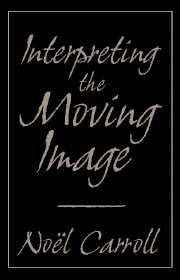Book contents
- Frontmatter
- Contents
- Foreword: Through Carroll's Looking Glass of Criticism
- Introduction
- 1 The Cabinet of Dr. Kracauer
- 2 Entr'acte, Paris and Dada
- 3 The Gold Rush
- 4 Keaton: Film Acting as Action
- 5 Buster Keaton, The General, and Visible Intelligibility
- 6 For God and Country
- 7 Lang, Pabst, and Sound
- 8 Notes on Dreyer's Vampyr
- 9 King Kong: Ape and Essence
- 10 Becky Sharp Takes Over
- 11 Interpreting Citizen Kane
- 12 The Moral Ecology of Melodrama: The Family Plot and Magnificent Obsession
- 13 Mind, Medium, and Metaphor in Harry Smith's Heaven and Earth Magic
- 14 Welles and Kafka
- 15 Nothing But a Man and The Cool World
- 16 Identity and Difference: From Ritual Symbolism to Condensation in Anger's Inauguration of the Pleasure Dome
- 17 Text of Light
- 18 Joan Jonas: Making the Image Visible
- 19 Introduction to Journeys from Berlin/1971
- 20 The Future of Allusion: Hollywood in the Seventies (and Beyond)
- 21 Back to Basics
- 22 Amy Taubin's Bag
- 23 Herzog, Presence, and Paradox
- 24 Film in the Age of Postmodernism
- Notes
- Index
18 - Joan Jonas: Making the Image Visible
Published online by Cambridge University Press: 05 June 2012
- Frontmatter
- Contents
- Foreword: Through Carroll's Looking Glass of Criticism
- Introduction
- 1 The Cabinet of Dr. Kracauer
- 2 Entr'acte, Paris and Dada
- 3 The Gold Rush
- 4 Keaton: Film Acting as Action
- 5 Buster Keaton, The General, and Visible Intelligibility
- 6 For God and Country
- 7 Lang, Pabst, and Sound
- 8 Notes on Dreyer's Vampyr
- 9 King Kong: Ape and Essence
- 10 Becky Sharp Takes Over
- 11 Interpreting Citizen Kane
- 12 The Moral Ecology of Melodrama: The Family Plot and Magnificent Obsession
- 13 Mind, Medium, and Metaphor in Harry Smith's Heaven and Earth Magic
- 14 Welles and Kafka
- 15 Nothing But a Man and The Cool World
- 16 Identity and Difference: From Ritual Symbolism to Condensation in Anger's Inauguration of the Pleasure Dome
- 17 Text of Light
- 18 Joan Jonas: Making the Image Visible
- 19 Introduction to Journeys from Berlin/1971
- 20 The Future of Allusion: Hollywood in the Seventies (and Beyond)
- 21 Back to Basics
- 22 Amy Taubin's Bag
- 23 Herzog, Presence, and Paradox
- 24 Film in the Age of Postmodernism
- Notes
- Index
Summary
The recent, untitled video/performance piece by Joan Jonas is more striking for its video than for its performance elements. Theatrically, the video imagery dominates the spectacle insofar as the live performance is most interesting in terms of the way it is reconstituted on video. This enables Jonas to focus on what might be thought of as an esthetic interrogation of the conditions of representation in video. Her video imagery is predominantly representational, but her treatment of it bypasses a concern with the referential or representational significance of the imagery in favor of a preoccupation with the representational power or scope of that imagery. That is, Jonas seems less concerned with what the imagery represents and more involved with how much it represents.
The piece begins with the audience assembled in an area defined by the presence of three television monitors and a camera. Two of the monitors face each other on a slightly diagonal north – south axis. Initially, these monitors determine the lateral limit of the audience. Spectators, seated on cushions, cluster around these monitors. Both the spectators' distance from the monitor and the spectators' posture are highly evocative of the everyday, home viewing of television. The third monitor is in front of the audience on the set of the performance. A camera, placed in front of the performance area, keeps the audience back from this third monitor, assuring that each spectator will have at least two, and in some cases three, distinct vantage points on the video imagery.
- Type
- Chapter
- Information
- Interpreting the Moving Image , pp. 228 - 233Publisher: Cambridge University PressPrint publication year: 1998

